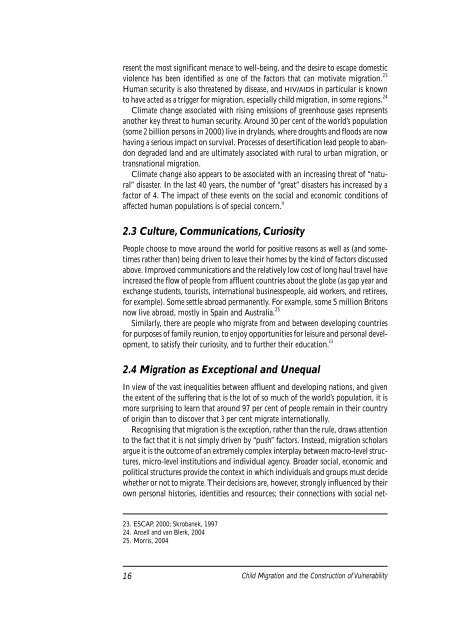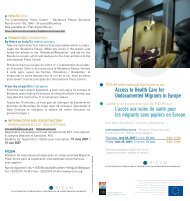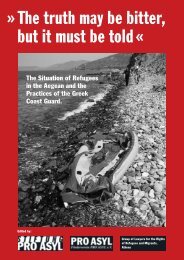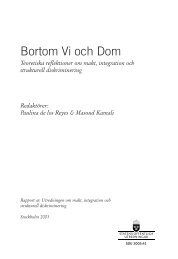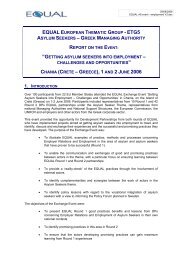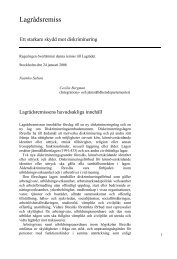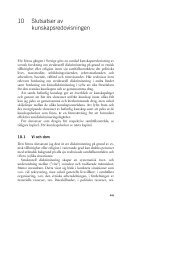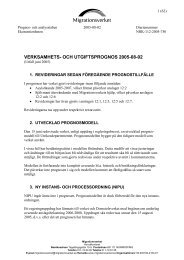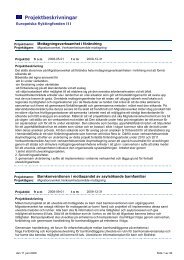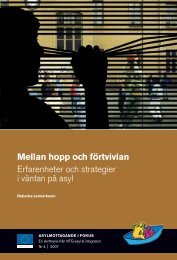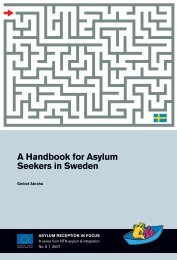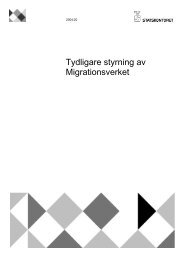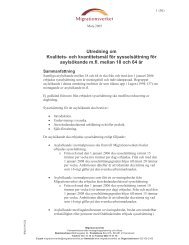and the Construction of Vulnerability - Child Trafficking
and the Construction of Vulnerability - Child Trafficking
and the Construction of Vulnerability - Child Trafficking
You also want an ePaper? Increase the reach of your titles
YUMPU automatically turns print PDFs into web optimized ePapers that Google loves.
esent <strong>the</strong> most significant menace to well-being, <strong>and</strong> <strong>the</strong> desire to escape domestic<br />
violence has been identified as one <strong>of</strong> <strong>the</strong> factors that can motivate migration. 23<br />
Human security is also threatened by disease, <strong>and</strong> HIV/AIDS in particular is known<br />
to have acted as a trigger for migration, especially child migration, in some regions. 24<br />
Climate change associated with rising emissions <strong>of</strong> greenhouse gases represents<br />
ano<strong>the</strong>r key threat to human security. Around 30 per cent <strong>of</strong> <strong>the</strong> world’s population<br />
(some 2 billion persons in 2000) live in dryl<strong>and</strong>s, where droughts <strong>and</strong> floods are now<br />
having a serious impact on survival. Processes <strong>of</strong> desertification lead people to ab<strong>and</strong>on<br />
degraded l<strong>and</strong> <strong>and</strong> are ultimately associated with rural to urban migration, or<br />
transnational migration.<br />
Climate change also appears to be associated with an increasing threat <strong>of</strong> “natural”<br />
disaster. In <strong>the</strong> last 40 years, <strong>the</strong> number <strong>of</strong> “great” disasters has increased by a<br />
factor <strong>of</strong> 4. The impact <strong>of</strong> <strong>the</strong>se events on <strong>the</strong> social <strong>and</strong> economic conditions <strong>of</strong><br />
affected human populations is <strong>of</strong> special concern. ii<br />
2.3 Culture, Communications, Curiosity<br />
People choose to move around <strong>the</strong> world for positive reasons as well as (<strong>and</strong> sometimes<br />
ra<strong>the</strong>r than) being driven to leave <strong>the</strong>ir homes by <strong>the</strong> kind <strong>of</strong> factors discussed<br />
above. Improved communications <strong>and</strong> <strong>the</strong> relatively low cost <strong>of</strong> long haul travel have<br />
increased <strong>the</strong> flow <strong>of</strong> people from affluent countries about <strong>the</strong> globe (as gap year <strong>and</strong><br />
exchange students, tourists, international businesspeople, aid workers, <strong>and</strong> retirees,<br />
for example). Some settle abroad permanently. For example, some 5 million Britons<br />
now live abroad, mostly in Spain <strong>and</strong> Australia. 25<br />
Similarly, <strong>the</strong>re are people who migrate from <strong>and</strong> between developing countries<br />
for purposes <strong>of</strong> family reunion, to enjoy opportunities for leisure <strong>and</strong> personal development,<br />
to satisfy <strong>the</strong>ir curiosity, <strong>and</strong> to fur<strong>the</strong>r <strong>the</strong>ir education. iii<br />
2.4 Migration as Exceptional <strong>and</strong> Unequal<br />
In view <strong>of</strong> <strong>the</strong> vast inequalities between affluent <strong>and</strong> developing nations, <strong>and</strong> given<br />
<strong>the</strong> extent <strong>of</strong> <strong>the</strong> suffering that is <strong>the</strong> lot <strong>of</strong> so much <strong>of</strong> <strong>the</strong> world’s population, it is<br />
more surprising to learn that around 97 per cent <strong>of</strong> people remain in <strong>the</strong>ir country<br />
<strong>of</strong> origin than to discover that 3 per cent migrate internationally.<br />
Recognising that migration is <strong>the</strong> exception, ra<strong>the</strong>r than <strong>the</strong> rule, draws attention<br />
to <strong>the</strong> fact that it is not simply driven by “push” factors. Instead, migration scholars<br />
argue it is <strong>the</strong> outcome <strong>of</strong> an extremely complex interplay between macro-level structures,<br />
micro-level institutions <strong>and</strong> individual agency. Broader social, economic <strong>and</strong><br />
political structures provide <strong>the</strong> context in which individuals <strong>and</strong> groups must decide<br />
whe<strong>the</strong>r or not to migrate. Their decisions are, however, strongly influenced by <strong>the</strong>ir<br />
own personal histories, identities <strong>and</strong> resources; <strong>the</strong>ir connections with social net-<br />
23. ESCAP, 2000; Skrobanek, 1997<br />
24. Ansell <strong>and</strong> van Blerk, 2004<br />
25. Morris, 2004<br />
16<br />
<strong>Child</strong> Migration <strong>and</strong> <strong>the</strong> <strong>Construction</strong> <strong>of</strong> <strong>Vulnerability</strong>


